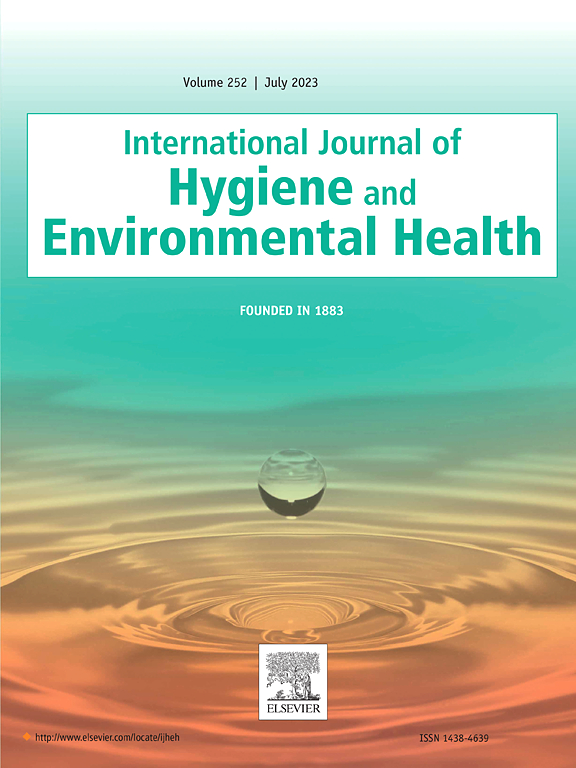Defining alarm thresholds for the load of pathogenic viruses in wastewater for decision making: An application to three French cities
IF 4.4
2区 医学
Q1 INFECTIOUS DISEASES
International journal of hygiene and environmental health
Pub Date : 2025-03-15
DOI:10.1016/j.ijheh.2025.114563
引用次数: 0
Abstract
Wastewater monitoring has the potential to complement infectious disease surveillance systems. However, the absence of predefined viral signal thresholds in wastewater is often presented as a limiting factor in triggering public health action. To overcome this issue, the feasibility of defining alarm threshold for viral loads in wastewater samples was assessed by quantifying genome fragments of SARS-CoV-2, influenza A virus (IAV), respiratory syncytial virus (RSV), norovirus (NoV), and rotavirus (RoV) by RT-digital PCR (dPCR) in untreated wastewater samples from three treatment plants. Cut-point values were calculated for periods with a high rate of visits to emergency rooms or at-home visits by SOS Médecins for the related diseases. ROC curves were constructed, and the values of alarm threshold in wastewater were defined using the Youden index. For each targeted virus, alarm thresholds were close to each other across the three WWTPs. As indicated by likelihood ratios, evidence to rule in the diagnosis of high rate of visits when the alarm threshold was exceeded ranged from weak to strong and was highest for RSV and SARS-CoV-2. Evidence to rule out the diagnosis when the alarm threshold was not exceeded was strong or moderate for IAV, SARS-CoV-2 and RSV. Diagnostic performance of the test was not as high for NoV and RoV. Positive predictive value was highest for SARS-CoV-2 and RSV.
For SARS-CoV-2 and RSV, the definition of an alarm threshold in wastewater could substantially inform the diagnosis of a period with a high rate of medical visits for COVID-19 and bronchiolitis, respectively.
确定用于决策的废水中病原病毒负荷的报警阈值:在三个法国城市的应用
废水监测具有补充传染病监测系统的潜力。然而,废水中缺乏预定义的病毒信号阈值往往被认为是引发公共卫生行动的限制因素。为了解决这一问题,本研究通过RT-digital PCR (dPCR)对3个污水处理厂未经处理的废水样本中SARS-CoV-2、甲型流感病毒(IAV)、呼吸道合胞病毒(RSV)、诺如病毒(NoV)和轮状病毒(RoV)的基因组片段进行定量分析,评估了废水样本中病毒载量报警阈值的可行性。计算了SOS m.m.因相关疾病到急诊室就诊或在家就诊比率较高的时期的切点值。构建ROC曲线,用约登指数定义废水报警阈值。对于每个目标病毒,三个wwtp中的警报阈值彼此接近。如似然比所示,当超过警报阈值时,诊断出高就诊率的证据从弱到强不等,其中RSV和SARS-CoV-2最高。对于IAV、SARS-CoV-2和RSV,在未超过警报阈值时排除诊断的证据是强烈或中度的。该测试对NoV和RoV的诊断性能不高。SARS-CoV-2和RSV阳性预测值最高。对于SARS-CoV-2和RSV,废水中报警阈值的定义可以分别为COVID-19和细支气管炎的高就诊率时期的诊断提供重要信息。
本文章由计算机程序翻译,如有差异,请以英文原文为准。
求助全文
约1分钟内获得全文
求助全文
来源期刊
CiteScore
11.50
自引率
5.00%
发文量
151
审稿时长
22 days
期刊介绍:
The International Journal of Hygiene and Environmental Health serves as a multidisciplinary forum for original reports on exposure assessment and the reactions to and consequences of human exposure to the biological, chemical, and physical environment. Research reports, short communications, reviews, scientific comments, technical notes, and editorials will be peer-reviewed before acceptance for publication. Priority will be given to articles on epidemiological aspects of environmental toxicology, health risk assessments, susceptible (sub) populations, sanitation and clean water, human biomonitoring, environmental medicine, and public health aspects of exposure-related outcomes.

 求助内容:
求助内容: 应助结果提醒方式:
应助结果提醒方式:


